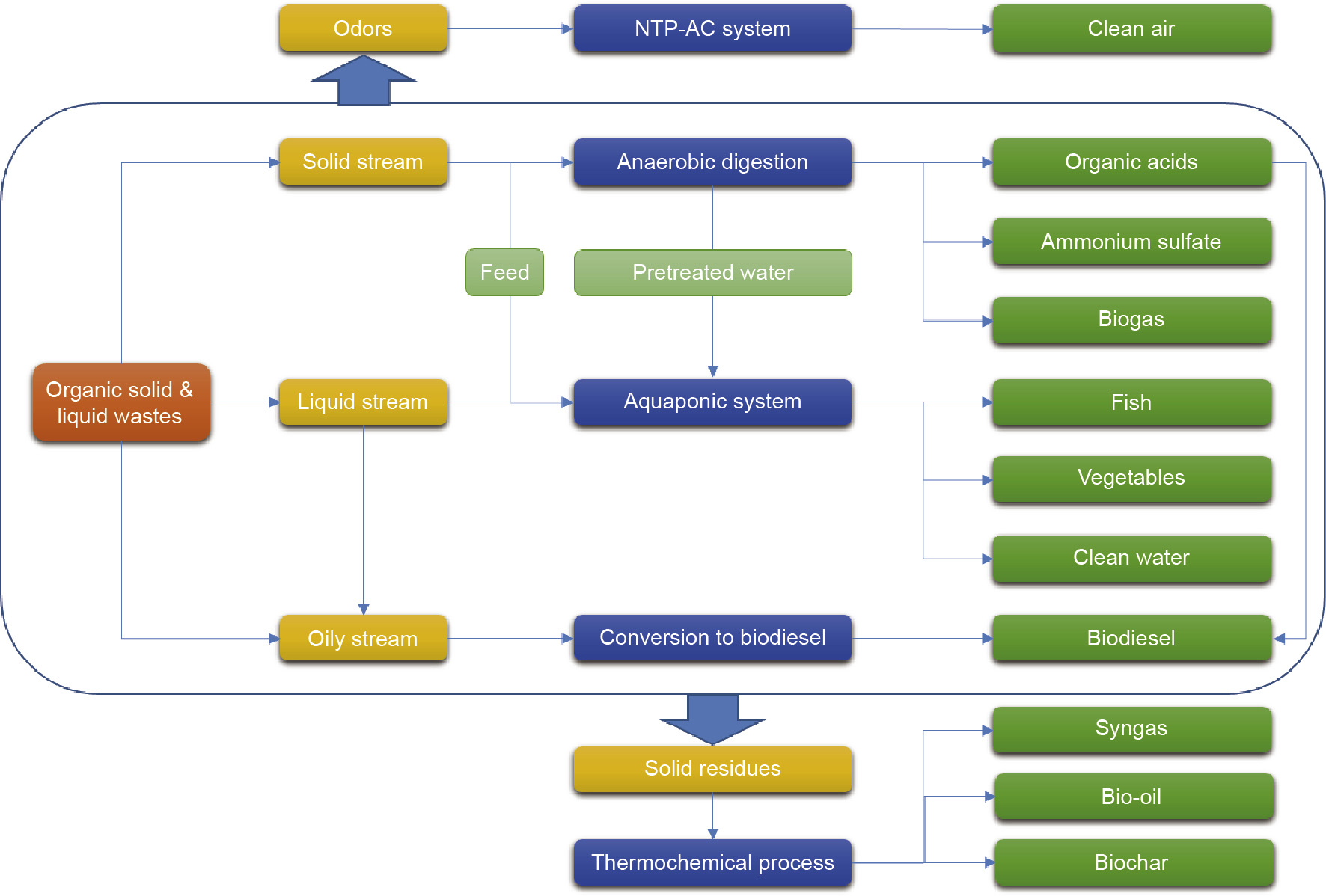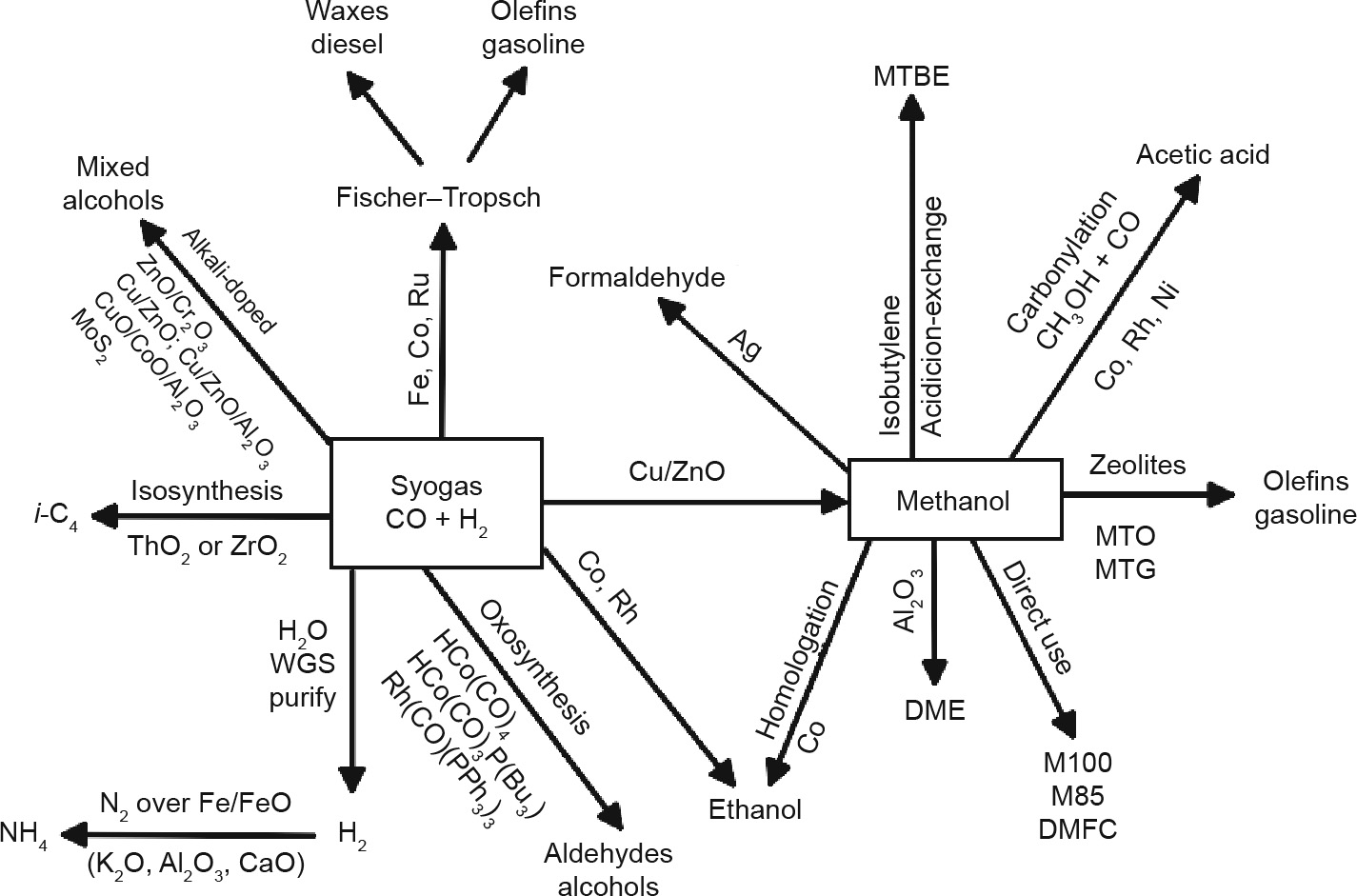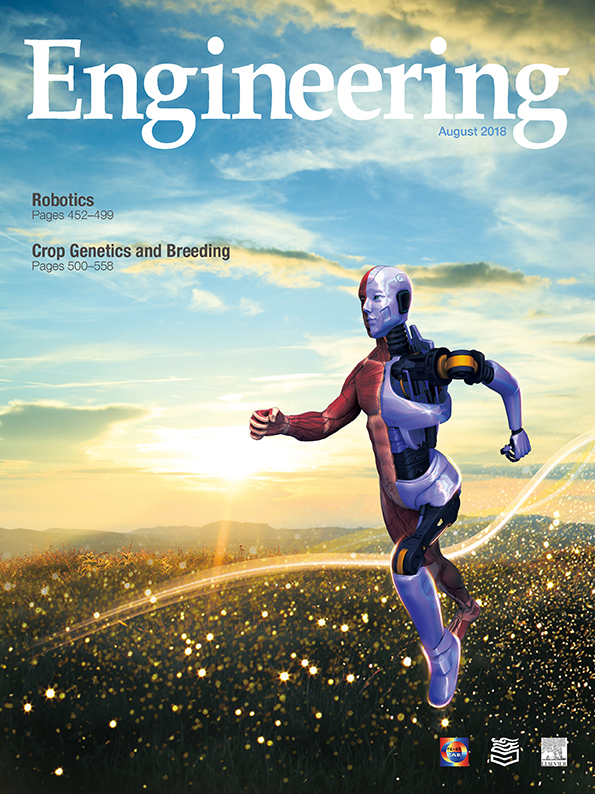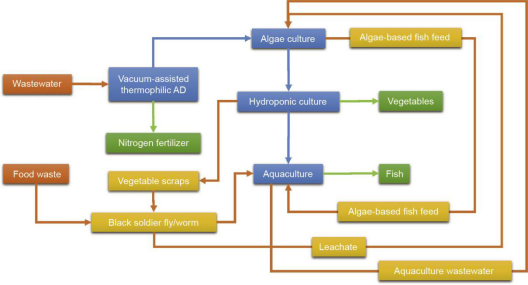《1.Introduction》
1.Introduction
The world generates tremendous amounts of solid and liquid wastes every year from sources that include domestic, commercial, industry, construction, and farming activities. Global municipal solid waste (MSW) annual generation exceeds 2×109 t. On a per capita basis, the developed countries produce at least five times more MSW than the developing countries. However, as the largest developing country, China alone generates more than 2×108 t MSW, accounting for more than 10% of the world’s MSW. If not dis posed of properly, MSW poses a serious threat to the environment. At present, composting, landfilling, and incineration are the main methods of nonrecyclable MSW disposal.In China, non recyclable MSW is primarily disposed of through landfill (65.5%) and incineration (32.5%) [1], both of which have the potential of causing unintended groundwater contamination [2] and air pollution [3].
China produced 6.85×1010 t municipal wastewater (MWW) in 2012 [4], while the United States produced around 4.46×1010 t in 2008 [5]. MWW treatment consumes 0.4% and 3%–4% of total electricity use in China [6] and the United States [7], respectively. Therefore, MWW is not only a large pollutant source but also a huge energy consumer and a source of significant energyrelated emissions. In addition to MWW, there are many other sources of wastewater; in particular, agricultural activities generate millions of tons of concentrated wastewater. Greenhouse gases (GHGs) such as methane (CH4) and carbon dioxide (CO2) are emitted from these wastewaters due to natural biological processes. Some of the MWW sludge and animal wastewater is used to produce biogas through controlled anaerobic digestion (AD) [8]. However, the majority of the resources in the wastewaters remains uncaptured.
Proper management and, especially, utilization of solid and liq uid wastes can have potential positive impacts on our environ ment,renewable energy and materials production, and economy. Solid and liquid wastes are composed of large amounts of organic materials and compounds that contain a great deal of recoverable energy. Table 1 lists the energy contents of major solid wastes. The world’s MWW contains 30×1015– 60×1015 kJ·a-1, given a chemical oxygen demand (COD) of 60–120 g per capita per day, an energy density of 17.6 kJ ·g-1 for COD, and 7.8 billion people in the world [9]. This does not include the energy present in agricul tural and industrial wastewaters. Therefore, there is a great poten tial to recover a tremendous amount of energy from solid and liquid wastes. Recent research has demonstrated that non recyclable waste materials and biosolids can be converted to usable heat,electricity, fuels, and chemicals through a variety of processes. Liquid waste streams can be sent through additional energy recovery options, with the potential to support agricultural crops and algae growth,and provide other usable byproducts.
《Table 1》
Table 1 Energy contents of MSWs.

1 Btu = 1.055 kJ.
The objectives of the present paper are: to describe biorefining schemes for the beneficial utilization of organic solid and waste water wastes as a sustainable waste management strategy; to identify technological options; and to present some important technical breakthroughs being developed in the authors’laboratories.
《2.Biorefining schemes》
2.Biorefining schemes
Considering the complexity of the chemical, physical, and bio logical properties of various solid and liquid wastes, multiple tech nologies may be required to maximize the energy and value recovery from the wastes. The physical and chemical states of a particular waste change during the management and utilization process. For example, solid sludge is produced during wastewater treatment, and the scum from an MWW treatment plant can be separated into three distinct streams namely, oil, water, and dry solids. Additional processes need to be brought in to deal with the new states and streams. This leads to the concept of biorefin ing, which has been broadly discussed in the field of biomass energy production.
Many different biorefining schemes have been proposed [10,11]. In biorefining schemes, biomass is used in the place of fossil oil as a feedstock in conventional petrorefining,through which biomass is converted to different forms of energy, chemicals,and materials, which may be conventionally derived from fossil resources (Fig. 1) [12]. This scheme is mostly designed for plant based biomass feedstocks, which contain high contents of lignocellulosics,sugars, or oil. Such feedstocks are not suitable for MSW, MWW, or agricultural and foodprocessing wastewater, which are generally relatively low in cellulosics, sugars, and oil (except oily scum), and high in moisture content. To tailor a biorefining scheme to these unique wastes,we propose a new systems approach illustrated in Fig. 2. This systems approach consists of processes that will enable the production of chemicals, fertilizer, energy (biogas, syngas, biodiesel, and biooil), foods, cleaner water, and a reduction in air pollution emissions. The core conversion technology blocks are the AD of wet solid and semisolid wastes;aquaponics using wastewaters; an oily waste to biodiesel process; and the thermochemical conversion of organic solids. Some of these technologies have been used in commercial applications but have not been without issues and challenges. In the next section, we will discuss these core technology options and report on the latest progress from ongoing research and development in the authors’laboratories.
《Fig.1》

Fig.1.Bioenergy from biomass through different pathways [12]. DME: dimethylether; F–T: Fischer–Tropsch; CHP:combined heat and power.
《Fig.2》

Fig.2. A biorefining approach to converting organic solid and liquid wastes to valueadded products while cleaning water and air.
《3.Technology options and new development》
3.Technology options and new development
《3.1.Conventional AD》
3.1.Conventional AD
For wet organic solids such as sludge and food wastes,and for highstrength wastewaters, AD is very effective in stabilizing these wastes and producing biogas as an energy source. Biogas, whose main component is methane, is used for electricity generation through combustion and for hydrogen production via catalytic reforming [13,14]. AD is quite robust to a different moisture content range of feedstocks, and is therefore suitable for a wide range of solid and liquid wastes, as long as they contain a sufficient carbon source and nutrients. Several issues affect the effectiveness and efficiency of AD technology. First, the remaining liquid and solid residues after AD still contain a certain level of nutrients, making them unsuitable for direct discharge. However, after solid–liquid separation, it is possible to use the liquid to cultivate microalgae and hydroponic crops, while converting the solids to biooil, syngas, and biochar through thermochemical conversion. Second, the concentration of free ammonia and hydrogen sulfide is often so high during the AD process that it inhibits methane production [15–17]. Third, as a related issue,the high sulfur content in the biogas can cause problems for gas turbines, and can result in high sulfur emission into the air when the biogas is combusted. Finally, the liquid portion,if containing highlevel ammonia, will not be suitable for hydroponic vegetable growth because of phytotoxicity. Ammonia is also toxic to fish in aquaculture [18].
《3.2.Vacuumassisted thermophilic AD》
3.2.Vacuumassisted thermophilic AD
To address the issues discussed above, we have been developing a thermophilic AD process in combination with vacuum treat ments [19]. Mesophilic AD operated at temperatures ranging from 30 to 40°C has been practiced worldwide for decades. It is still recommended for treating highstrength animal manures because of the higher robustness of the process compared with thermophilic AD. On the other hand,thermophilic AD offers a num ber of advantages over mesophilic AD, including higher organic matter degradation, higher pH, higher CH4 yield,higher percentage of ultimate CH4 retrieved,and lower residual CH4 emission[20].
In a very recent study conducted in our laboratories [19], a vac uum was applied to the substrates before and during thermophilic AD for the purpose of removing ammonia and hydrogen sulfide from the AD system. Two different vacuum treatments were inves tigated.We first used a thermal vacuum as a pretreatment of liquid swine manure to strip ammonia and hydrogen sulfide prior to ther mophilic AD. This treatment is termed thermal vacuum stripping (TVS). The effects of vacuum pressure and temperature levels were investigated. Vacuum pressure was shown to be the primary factor affecting TVS efficiency. Over 98%of ammonia, 38% of organic nitrogen, and 80% of hydrogen sulfide were removed at 55°C,100.63±3.79 mmHg (1mmHg=133.28 Pa) vacuum, and an initial pH of 10 in one hour through the TVS process. Methane productivity in batch testing with unacclimated sludge was improved from 11.56±1.75%to 17.60±0.49%in 25 d, with a 40%shorter hydrolysis stage. TVSAD could be an effective strategy to improve the efficiency of liquid swine manure hydrolysis, whose effluent can be utilized in algae cultivation and/or hydroponic systems.In an ongoing study, we investigated the second vacuum treatment experiment,in which a vacuum was applied to the substrates dur ing the thermophilic AD process.It was noticed that an intermittent vacuum treatment was sufficient to remove a significant amount of ammonia and hydrogen sulfide while saving energy and simplifying the operation. It is also possible to control their removal rates by varying the vacuum treatment conditions (i.e.,pressure and time). In both vacuum treatments, the stripped ammonia and hydrogen sulfide were absorbed by a sulfuric acid solution and a sodium hydroxide solution to form ammonia sulfate and sodium sulfide,respectively. Ammonia sulfate and sodium sulfide can be collected for use as a fertilizer (ammonia sulfate) and a bleaching agent in paper and textile industries (sodium sulfide). The significance of the vacuumassisted thermophilic AD lies in the ability of the novel AD process to effectively degrade organic matter in both municipal and agricultural wastewaters and gener ate a high yield of methane, while costeffectively stripping ammo nia and hydrogen sulfide. This results in a liquid with a much lower nutrient loading and, in particular, lower ammonia level,which is important—and sometimes critical—to the further use of the liquid for microalgae and aquaponic production.
《3.3.Extended aquaponics》
3.3.Extended aquaponics
Aquaponics (i.e.,aquaponic systems) has emerged as a globally accepted food production model,in which aquaculture water con taining a certain level of unused nutrients and nutrients excreted by fish is recirculated and used for the production of hydroponic plants. In turn,the plants act as one of several biofilters to clean and purify the water for aquaculture. Aquaponics has a number of advantages over traditional agriculture/horticulture and aquaculture: ① It requires much less exchange/disposal of water that is rich in nutrients; ② it significantly reduces the loss of water due to leaking to soil and groundwater; and ③ it reuses mineral nutrients. All of these advantages contribute to a lower use of water and mineral nutrients. Water is considered to be a precious resource,and maintaining a clean water source is becoming increasingly important. It is a stunning fact that global agriculture consumes 70% of the freshwater resources on earth for crop pro duction [21]. It was estimated that hydroponic production of let tuce used 12 times less water than traditional agricultural production [22]. Fish production through integrated recirculating aquaculture uses less than 1%of the water required in pond culture to produce equivalent tilapia yields [23]. Therefore,aquaponic pro duction systems are significantly more efficient than conventional production systems in terms of water usage,and lend themselves best to regions where water is scarce.In addition,aquaponic pro duction has a much higher yield and productivity per unit of land,nutrient,and water input, and can easily be adapted to green or organic production practices.If practiced in urban areas, it can sig nificantly shorten production supply chains.
The practice of aquaponics is still facing technical,socioecological,and economic challenges,but there are many opportunities to be explored [21,24]. Research is being conducted in the authors’laboratories to investigate the use of animal wastewater and foodprocessing wastes for aquaponic production, with an aim to develop a zerodischarge recirculating production strategy. Fig. 3 shows the process flow diagram for an extended aquaponic system concept.The extended system includes:a vacuumassisted thermophilic AD reactor,in order to produce methane and prepare the remaining highstrength wastewater for aquaponic production by stripping excess ammonia and hydrogen sulfide; a microalgae cultivation process, in order to further reduce the ammonia,break down residual organics,and produce algaebased fish feed;and a black soldier fly/worm production component, in order to provide fish feed from food and other solid biowastes.Since mineral nutrients are provided by both the animal wastewater and the fish wastewater, the hydroponic production is expected to be larger than that in common aquaponic systems, which rely on fresh water. The aquaculture component consists of some filtration and biofiltration stations in addition to a fish tank.Recent research found that the microalgae component not only helps to remove ammonia and total nitrogen, but also helps to compensate for the pH drop caused by nitrification bacteria. The research also showed that by carefully controlling the capacity of the microalgae component, the microalgae would not compete for nutrients with the hydroponic vegetables. If controlled adequately,all nutrients are utilized and no water is discharged to the surface. Intensive research and development efforts have been planned to balance individual components in the system and conduct mass and energybalance analyses. A technoeconomic analysis and a life cycle analysis will also be carried out to provide financial and envi ronmental assessment of the technology.
《Fig.3》

Fig.3.The process flow diagram for an extended aquaponic system concept.
《3.4.Oily wastes to biodiesel process》
3.4.Oily wastes to biodiesel process
Oily wastes include fat, oil, and grease (FOG) from a number of sources such as MWW scum,foodprocessing scum,grocery store and warehouse wastewater scum, waste cooking oil, and so forth. Oily wastes clog drains and wastewater collection and treatment systems. They can also pose a threat to the environment and human health. Oily wastes are usually treated either by AD, in order to produce low energydensity biogas, or by landfilling, which causes serious environmental concern.The high demand for renewable biodiesel opens an opportunity for oily waste uti lization,since the use of virgin vegetable oil as a feedstock has become very costly for the biodiesel industry. Waste cooking oil is now being collected for biodiesel production because it is relatively clean.Scum has the lowest grade among biodiesel feedstocks,by far. Its high soap and free fatty acid (FFA) content (>90%), many impurities, and high moisture emulsified with the main oil complex make it very difficult to extract the oil compo nent. In its unpurified state,the standard biodiesel process cannot handle the oil extracted from scum. Lowgrade oil feedstock with about 30% FFAs can be converted through a twostep process, in which an acidcatalyzed pretreatment is used to esterify the FFAs, followed by transesterifying the triglycerides with an alkaline cat alyst [25]. When oily wastes (i.e.,scums) contain oil with greater than 30% FFAs and with many other impurities, the twostep process is inefficient or does not work at all.
New processes in the authors’laboratories are capable of converting the fatty acids, lipids,and soap in scum directly to ASTMgrade biodiesel [26,27]. Soap and finesolids particles are removed from scum using an acid wash combined with solvent extraction so that the extracted oil component is suitable for the downstream process.Instead of using the lowtemperature two step process,in which recycling methanol can be an energy intensive process because methanol and water have very close boiling points, we developed an alternative process based on a glycerin esterification reaction known as "glycerolysis,”in which glycerol reacts with FFAs to produce glycerides and water [27]. Because the reaction occurs at 238°C, any water produced during glycerolysis is evaporated and then purged from the reactor by nitrogen gas. The resultant oil is dry and suitable for the transesterification process that follows. Our study showed that although the reaction temperature is high,the overall energy consumption is low,and the heat can be recycled to preheat the incoming flow. This novel process has been demonstrated on a small pilot scale and has the potential to be adapted to other highFFA oil feedstocks.A lifecycle analysis showed that the MWW scum to biodiesel process has the potential to be both more economical and more environmentally sound than current practices such as AD and combustion [28].
《3.5.Microwaveassisted thermochemical conversion》
3.5.Microwaveassisted thermochemical conversion
Gasification and pyrolysis are thermochemical processes that are considered to be viable options for biomass conversion [29]. They have been practiced in many parts of the world. Gasification produces syngas through the partial combustion of biomass at high temperatures (>800°C). The syngas, a mixture of carbon monoxide (CO), hydrogen gas (H2), CO2, CH4, and some light hydrocarbons,can be used to generate heat and electricity through combustion. It can also be converted to chemicals via traditional Fischer Tropsch and other novel catalytic reforming processes (Fig. 4) [30]. Syngas may contain contaminants such as hydrogen sulfide, hydrochloric acid (HCl), tar, and solid particles, which must be removed through sophisticated cleaning processes before it can be used [31,32]. Pyrolysis converts organic feedstock to biooil,biochar,and pyrolytic gas at moderately high temperatures (300–700°C) in the absence of oxygen. The ability of pyrolysis to liquefy solid biomass and produce biooil makes it a desirable option for the production of muchdemanded liquid fuels, which have a higher energy density and are easier to handle than gaseous fuels. Both gasification and pyrolysis processes are superior to incineration in terms of pollutant emission and energy recovery.
《Fig.4》

Fig.4. Pathways for syngas reforming [30]. DME: dimethylether; DMFC: directmethanol fuel cell; MTBE: methyl tertbutyl ether; MTG:methanol to gasoline; MTO: methanol to olefins; WGS: water gas shift.
There are many types of gasification and pyrolysis methods, which differ in heating media and rate,and in material flows. They also offer different product compositions, quality,efficiency,and ability to handle feedstocks with different physical and chemical properties (i.e.,size,moisture content,uniformity,lignin content,etc.). New thermochemical conversion processes using microwave heating have been developed in the authors’laboratories [29]. Microwave heating has many advantages over conventional con duction heating. Microwave heating is characterized by internal heating. During microwave heating of biomass, heat flow and mass (volatiles) flow are concurrent, as opposed to the countercurrent flows that occur during conventional heating. Other advantages of microwaveheatingbased biomass conversion include: its ability to handle larger size and highly inhomogeneous biomass particles; its absence of a carrier gas, which would otherwise dilute the products; and its lack of fluidization and violent mixing, so that the ash and particulate contents in the products are significantly reduced. Pyrolysis and gasification using microwave heating, dubbed "microwaveassisted pyrolysis”(MAP)and" microwave assisted gasification”(MAG), have been tested on a number of feedstocks. Recently, significant progress has been made in improving the heating rate and temperature by incorporating microwave absorbent into the process [33].This addition upgraded the process from an intermediate heating rate process to a fast heating rate process,making fast microwaveassisted pyrolysis (fMAP) and fast microwaveassisted gasification (fMAG)feasible [29,33]. Several generations of pilotscale systems have been demonstrated. The latest generation can be operated at temperatures as high as 900°C, with heating rates around 250°C s-1 depending on feedstock.The unique features of a microwave assisted conversion process are highly suitable for MSWs,which are generally inhomogeneous in moisture content, chemical com position,and geometry.
《4.Conclusions》
4.Conclusions
Amounts of organic solid and liquid wastes are on the rise, put ting tremendous pressure on the management of these wastes, while simultaneously presenting opportunities for beneficial uti lization. No single universal technology is capable of handling wastes of such a complex nature. Borrowing the concept from petroleumrefining processes, many biorefining schemes for ligno cellulosic biomass have been proposed. However, these schemes are unsuitable for municipal, agricultural, and food and biological processing wastes. We have proposed new biorefining schemes that are intended for the complete utilization of these wastes for the production of energy, fuels, foods, and feeds, while simultane ously cleaning water and reducing air emissions. The four core breakthrough technologies—that is, vacuumassisted thermophilic AD, extended aquaponics, oily wastes to biodiesel via glycerolysis,and microwaveassisted thermochemical conversion—that we have developed hold the potential to advance the new biorefining schemes to the next level. Each technology has unique characteris tics and features, which may cause it to function best for certain waste streams and certain situations. The vacuumassisted ther mophilic AD is suitable for the treatment and utilization of solid wastes and concentrated wastewaters,and may not be the best method for lowering pollutants to a very low level (e.g.,for dis charge purposes). The extended aquaponics requires the water entering the systems to contain a low concentration of nutrients and particles, and is a suitable process for the final stages of wastewater treatment. The oily waste to biodiesel via glycerolysis technology is best suited for oily wastes with lowgrade oily compounds. The robust microwaveassisted thermochemical conver sion processes are able to handle a wide range of solid wastes, such as biomass and municipal wastes.Highmoisturecontent solid wastes will need extra energy for water removal prior to ther mochemical conversion. Products from the thermochemical con version usually require extra steps for upgrading and refining. Further efforts to improve these technologies and demonstrate their economic and environmental benefits on a larger scale are needed in order to move the technologies toward commercial implementation.
《Acknowledgements》
Acknowledgements
The authors would like to express their appreciation to Depart ment of Transport/Sun Grant, US Department of Agriculture/Department of Energy, Minnesota LegislativeCitizen Commission on Minnesota Resources,Metropolitan Council Environmental Services,University of Minnesota MNDrive programs,University of Minnesota Center for Biorefining, and China Scholarship Council(CSC) for their financial support for this work.
《Compliance with ethics guidelines》
Compliance with ethics guidelines
Paul Chen, Erik Anderson, Min Addy, Renchuan Zhang, Yanling Cheng, Peng Peng,Yiwei Ma,Liangliang Fan, Yaning Zhang,Qian Lu, Shiyu Liu, Nan Zhou, Xiangyuan Deng, Wenguang Zhou, Muhammad Omar, Richard Griffith, Faryal Kabir, Hanwu Lei, Yunpu Wang, Yuhuan Liu,and Roger Ruan declare that they have no conflict of interest or financial conflicts to disclose.


















 京公网安备 11010502051620号
京公网安备 11010502051620号




